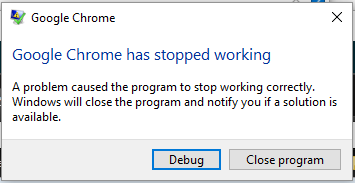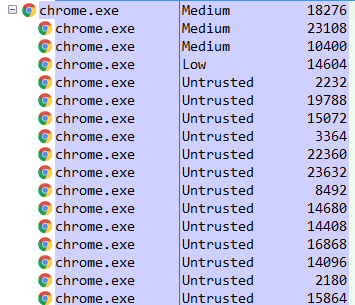This project presents 4 demo programs showing how to break thread stack expansion in Windows. Stack area auto expansion is surprisingly fragile such that an application can even break the other process's stack guard page and it can cause a clueless crash sometime later.
-
How to compile and Run demo program
- Open Visual C++ command prompt.
- To compile, go to Src folder and enter
cl.exe /Ox /EHsc demoN.cpp(N is number and currently 1, 2 or 3) - Enter
demoX.exeto run the demoX.
-
As a first step, all demo programs get stack top address of main thread from TIB (Thread Information Block).
- This demo programs were originally tested on Windows 7 and the behavior might have changed in the later Windows versions.
-
In this demo,
AccessStackGuardMemoryfunction is simply trying to read the memory address at the beginning of the one page (4KiB) above the current stack top address. (Remember stack grows to lower address from higher address). -
Command line to compile:
cl.exe /Ox /EHsc demo1.cpp /link /stack:262144(Set max stack size as 256KiB). -
It continues to move the memory pointer up by 1 page (in other words, subtract 0x1000 from the current address) and tries to read
int(4 bytes) value. You can hit any key other than ESC to continue to move to the next pages. -
This is essentially simulating nested function calls where each function allocates or uses 4KiB stack memory for local variables.
-
The stack guard page is set up above the current stack top by Windows. Whenever this program is trying to access (read) a memory location in the guard page area,
STATUS_GUARD_PAGE_VIOLATIONexception occurs. This exception is caught by the Windows Kernel exception handler and it'll expand or commit current stack by 1 page. -
When you keep hold a non-ESC key for a while, this program will eventually hit stackoverflow exception (0xC00000FD) because it'll hit the maximum stack size which is specified at link time. (Default is 1MiB)
-
There is a linker option
/STACK:reserve[,commit]sets the size of the stack. Default reserve size is 1 MiB. On my Windows 10, the minimum reserved stack size seems 256 KiB because the value is ignored if I specify smaller than 256 KiB. -
While running, launch Vmmap.exe and select
demo1.exe -
Hit key and on the command window where
demo1.exeis running to expand the stack then go back to the vmmap and refresh. You can see the commit memory is growing.
- This program tries to just READ main thread's stack guard pages from a different thread in same process.
- What this program does:
- Set up unhandled exception filter to catch and write to console when Windows structured exception is thrown.
- Create a new thread and passes main thread's stack limit address (stack top).
- In a new thread, try to read above the stack top address where main thread's stack guard page exists.
- You can see
STATUS_GUARD_PAGE_VIOLATION(OurUnhandledExceptionFilter receives the exception) is thrown whenever try to access stack guard page. Normally when thread stack is grown and touched the guard page, theSTATUS_GUARD_PAGE_VIOLATIONexception is handled by Kernel code so you won't see the exception. However, in this demo, if the guard page is touched by other thread then no stack expansion happens. If you continue to hit key, it eventually tries to access above the stack guard pages and you will seeACCESS_VIOLATIONexception. - As far as I remember, in previous versions of Windows (Maybe including Windows 7 but not 100% sure), Windows didn't even throw the
STATUS_GUARD_PAGE_VIOLATIONexception but it just blew up the guard pages. This will lead to an obscure access violation crash some time later.
- Modified Demo 2 a little bit.
ThreadProcaccesses (3 pages) above the current stack top to break all 3 stack guard pages. Then callingCrash()function which allocates a large size local variable. - The
Crash()function throwsACCESS_VIOLATIONand never returns. - This program is showing that a random memory read on other thread stack's guard pages can cause access violation later. Although, this kind of crash should be very rare and probably almost never happen if your program is well-written.
This is the last demo but the most interesting scenario. A malicious process is just doing READ access on the other process thread's stack guard page and it will cause access violation crash of the victim process. An important thing to note. The access violation does not happen immediately after the victim process's stack guard pages are broken. The crash will happen later when any one of the victim process's threads starts using more stack memory that requires stack expansion. The crash will be mostly clueless to the victim process and the crash dump doesn't tell much about what really happened.
-
Malicious process needs following privileges to target victim process.
PROCESS_QUERY_INFORMATION | PROCESS_VM_READ | PROCESS_CREATE_THREAD
-
Executing
IsBadCodePtrfrom the threads in the victim process.- This may be another good reason that Microsoft is trying to discontinue the
IsBadCodePtrAPI (https://msdn.microsoft.com/en-us/library/windows/desktop/aa366712(v=vs.85).aspx)
- This may be another good reason that Microsoft is trying to discontinue the
-
As an example, let's cluelessly crash the Google Chrome browser:
-
Compile command line is slightly different for this demo
- Use
cl.exe /Ox /EHsc demo4.cpp Shlwapi.lib Advapi32.lib
- Use
-
Launch Chrome and load couple of tabs.
- I opened 3 YouTube tabs.
-
Run demo4.exe like below on command line.
demo4.exe chrome.exe
-
Go back to the Chrome browser click individual tab.
- You are likely see some of tabs are crashed. If it's not crashing, you can try again or load other more expensive web site.
-
Sometimes main Chrome process is killed that also kill all of its child processes then Windows Error Reporting dialog pops up.
-
When you attach debugger, you will see something like below. It's access violation in random function. Unfortunately it won't tell what really happened.
-
-
If you run demo4 process at low integrity level, it cannot open chrome processes running at
mediumlevel. However, there are still chrome processes running atlowanduntrustedintegrity level and demo4 be able to blow their stack guard pages. Although, it can't crash the main Chrome process since the parent Chrome process is running atmediumlevel.- Run this command to change integrity level (from Administrator command prompt)
icacls demo4.exe /setintegritylevel low
- Run this command to change integrity level (from Administrator command prompt)
- The demo programs are showing how stack growing mechanism is fragile especially in multi-threaded environment. A subtle bug in one thread that inadvetently reads other thread's stack guard page area can crash the application.
- See this Mark's blog for thread stack expansion details.
- Allowing just
PROCESS_VM_READright can lead serious security issue like allowing crash your application from any other apps. See this Blog and IsBadxxxPtr APIs are dangerous - .NET commits whole thread stack memory (no run-time growing). They've chosen reliability over more memory consumption.
- For game servers, I always committed whole thread stack memory at the thread initialization time especially for the worker threads in game server. I think eliminating run-time stack growing will give tiny bit of perf benefits as well. :)







